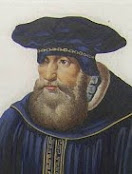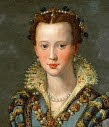Vannozza dei Cattanei - popes’ mistress
Mother of Lucrezia and Cesare Borgia was figure of influence
Vannozza dei Cattanei, who was for many years the chief mistress of Cardinal Rodrigo de Borgia - later Pope Alexander VI - was born on July 13, 1442 in Mantua. Herself from the aristocratic Candia family, Vannozza - baptised as Giovanna de Candia - grew up to be a beautiful woman but also a successful businesswoman, acquiring a number of osterie - inns - after she moved to Rome. In 15th century Italy, it was not unusual for cardinals and popes to have mistresses, despite Holy Orders coming with a vow of celibacy. Before her relationship with Rodrigo de Borgia, Vannozza allegedly was mistress to Cardinal Giuliano della Rovere, the future Pope Julius II and a rival to Borgia in the 1492 papal election that he won. Rodrigo made no attempt to hide his sexual dalliances, acquiring the nickname Papa Cattivo - the naughty pope. Read more…
_____________________________________
Jarno Trulli - racing driver and winemaker
Ex-Formula One star still winning prizes
The racing driver-turned-winemaker Jarno Trulli was born on July 13, 1974 in Pescara on the Adriatic coast. Trulli competed in Formula One from 1997 until 2011, competing in more than 250 Grands Prix. He enjoyed his most successful season in 2004, when he represented the Mild Seven Renault team and finished sixth in the drivers’ championship. He retired from racing in 2014-15 to focus on his winemaking business, which he had established while still competing and which now produces more than 1.2 million bottles every year. Trulli’s Podere Castorani vineyard, situated near the village of Alanno, some 35km (22 miles) inland of Pescara, focuses largely on wines made from Abruzzo’s renowned Montepulciano grapes. Although he was familiar with vineyards as a boy - his grandfather was a winemaker - Trulli’s parents were motorsports fans. Read more…
_____________________________________
Tommaso Buscetta - Mafia ‘pentito’
Sicilian gangster’s testimony put hundreds behind bars
The Sicilian mobster Tommaso Buscetta, who was the first major Mafia figure to break the code of omertà and pass details of organised criminal activity to the authorities, was born on July 13, 1928 in Palermo. His evidence to the celebrated anti-Mafia judge Giovanni Falcone paved the way for the so-called Maxi Trial, a process lasting six years that led to the conviction and jailing of 350 mafiosi. Buscetta’s testimony in the Pizza Connection Trial in New York State at around the same time in the mid-1980s led to the conviction of several hundred more mobsters both in Italy and the United States, including the powerful Sicilian Mafia boss Gaetano Badalamenti. Arguably the most shocking information he passed on to the authorities concerned Italy’s three-times former prime minister, the late Giulio Andreotti, whose links with the Cosa Nostra he exposed. Read more…
Giulio d’Este of Ferrara
Plots and prison ruin life of handsome son of Duke
Giulio d’Este, who spent more than half of his life in prison for taking part in a failed conspiracy against his half-brother, the Duke of Ferrara, was born on July 13, 1478 in Ferrara. He was the illegitimate son of Ercole I d’Este, an earlier Duke of Ferrara, born as a result of an affair the Duke had with Isabella Arduin, a lady in waiting to his wife. Giulio was often in conflict with his half-brothers, Alfonso and Ippolito, which led to him eventually playing his part in a plot to assassinate them. He had grown up in the court of Ferrara and later lived in a palace on the Via degli Angeli in Ferrara. The first major conflict between Giulio and Ippolito arose over a musician, Don Rainaldo of Sassuolo. Rainaldo was in the service of Giulio, but Ippolito, who had by then become a Cardinal, wanted him for his chapel and so in 1504 he abducted Rainaldo. Read more…
_____________________________________
The founding of the Carabinieri
Italy’s stylish ‘First Force’
The Carabinieri Corps was created on July 13, 1814 in Italy by a resolution passed by Victor Emmanuel I of Savoy. He established an army of mounted and foot soldiers to provide a police force, to be called Royal Carabinieri (Carabinieri Reali). The soldiers were rigorously selected ‘for their distinguished good conduct and judiciousness.’ Their task was defined as ‘to contribute to the necessary happiness of the State, which cannot be separated from protection and defence of all good subjects.’ Their functions were specified in the royal licence issued at the time, which underlined the importance of the personal skills required by the soldiers selected. It also affirmed their dual military and civil roles. The sense of duty and high level of conduct displayed by the Carabinieri went on to win the respect of the Italian people. Read more…
_______________________________________
Book of the Day: The Borgias, by Christopher Hibbert
The name Borgia is synonymous with the corruption, nepotism, and greed that were rife in Renaissance Italy. The powerful, voracious Rodrigo Borgia, better known to history as Pope Alexander VI, was the central figure of the dynasty. Two of his seven papal offspring also rose to power and fame - Lucrezia Borgia, his daughter, whose husband was famously murdered by her brother, and that brother, Cesare, who served as the model for Niccolò Machiavelli's The Prince. Notorious for seizing power, wealth, land, and titles through bribery, marriage, and murder, the dynasty's dramatic rise from its Spanish roots to its occupation of the highest position in Renaissance society forms a gripping tale. Warlords, Popes, Poisoners - The Borgias is the true story of the first family of the Italian Renaissance.Christopher Hibbert was an English writer, historian and biographer, the most widely-read popular historian of his time and one of the most prolific. He was a Fellow of the Royal Society of Literature and the author of many books, including The Story of England, Disraeli, Edward VII, George IV, The Rise and Fall of the House of Medici, and Cavaliers and Roundheads. The Borgias was his final book before his death in 2008.
.jpg)





.jpg)








.jpg)



.jpg)

